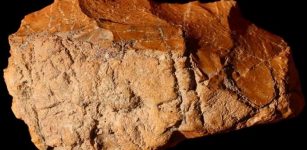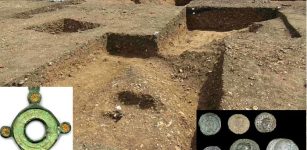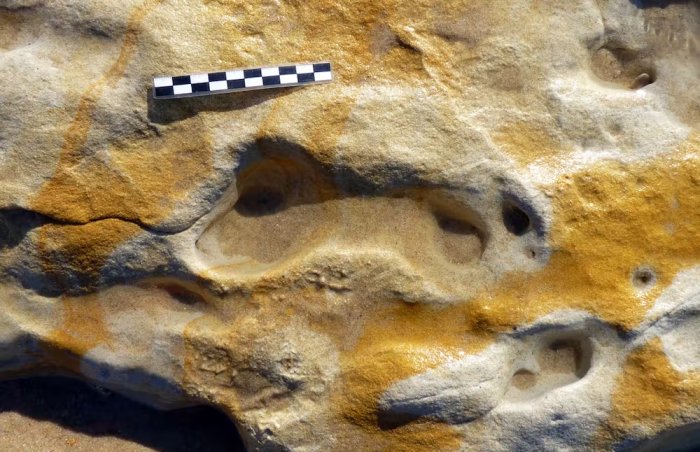Recently Found ‘Neanderthal Footprints’ In the South Of Spain Could Be 275,000 Years Old
AncientPages.com - A little over a year ago we reported on a large area at the foot of the Asperillo cliff, on the coast of the Doñana Natural Area in Huelva, Spain. There, along with numerous animal footprints, other footprints had been found—those of hominids.
General view of the site at Matalascañas beach, Huelva, and various hominid footprints discovered there. E. Mayoral, Author provided.
Until then, the only time reference that allowed the age of the site to be established was the dating of one of the dunes that covered the surface to around 106,000 years ago (Upper Pleistocene). As with most of the hominid footprints found worldwide, we dated them in line with the environment in which they were found. For this reason, our first hypothesis when trying to attribute the new found footprints was that they belonged to Neanderthals, who lived in the Upper Pleistocene.
However, in the course of the investigation, we sampled the surface where the footprints were found, which had never been dated before, and the dunes above. It turned out to be about 295,800 years old (Middle Pleistocene): this is to say, much earlier than previously thought.
Drastic climate change
The new dating placed the footprints in a new geographical and environmental context. The European continent was about to undergo drastic climate change 300,000 years ago. Relatively warm conditions were changing to much colder conditions, a precursor to a an ice age. At that time, the sea level on the European continent was on average about 60 meters below its present level, which implies that the Huelva coastline would be 20 to 25 kilometers offshore from its present position.
In other words, the coastal plain was very extensive and probably created by the delta of the river. It was probably covered by water during the wet seasons and totally or partially exposed during the dry seasons.
One of the hominid footprints analysed. E. Mayoral, Author provided.
Over this shallow and saline lake environment, made of polygonal ground and microbial covers, that hominids and other fauna trampled. Today, the same kind of polygonal covers are found in extensive areas of marshland in both hot desert and tropical climates.
More or less extensive vegetated areas would be found in the non-flooded areas of this wide coastal plain.
Around them, there would be a significant development of dune systems that would move landward from the coast.
New suspects?
The environmental context and the landscape have changed in relation to the initial interpretation. The question, therefore, became whether our understanding of who produced these footprints should also change. The answer is to be found in the paleontological record.
Hominid fossils belonging to the Middle Pleistocene are thought to be from the Neanderthal lineage: Homo neanderthalensis and Homo heidelbergensis. However, their remains are still very scarce, fragmentary and geographically dispersed. Worse still, footprints are even scarcer than skeletal remains. In the entire European Middle Pleistocene, only four sites have provided traces from this period: Terra Amata, in France (380,000 years old), Roccamonfina, in Italy (345,000 years old, attributed to Homo heidelbergensis), Biache-Vaast, in France (236,000 years old, Homo neanderthalensis) and Theopetra, in Greece (130,000 years old, Homo neanderthalensis).
E. Mayoral, Author provided.
On the other hand, it must be considered that the formal characteristics of the footprint are not only the result of the anatomy of the foot, but also of other factors such as biomechanical characteristics, the type of substrate and the processes that gave rise to the fossil. Therefore, the footprints studied must be well preserved and reflect several anatomical features (arch impression of the toes), which is rarely the case in places like this site in Huelva.
To confirm which hominid group the footprints belong to, we would need to compare their anatomical characteristics with the known skeletal record for the Middle Pleistocene.
Almost all the foot fossils known for this period come from the Sima de Los Huesos site (Atapuerca, Spain) and are associated with individuals related to Neanderthals. Making a more precise attribution would be difficult, as there are many debates about the evolution of this lineage, but also about the taxonomic definition of Homo heidelbergensis.
Read also this news on the same subject!
Enigmatic Footprints Reveal Humans Were In Spain 200,000 Years Earlier Than Previously Thought
Different models for the evolution of the Neanderthal lineage have been proposed, but this question is still far from being resolved, given the paucity of the fossil record and the new and more complicated evolutionary picture provided by the latest ancient DNA studies. Moreover, not all anatomical traits evolved at the same rate and polymorphisms probably occurred in different traits at different rates of occurrence.
Despite these uncertainties, the Doñana site proves to be a crucial record for understanding human occupations in Europe during the Pleistocene. Our recent dating opens up a broader horizon of possibilities. For example, we may be looking at the remains of very early Neanderthal hominids or their more directly related ancestors, Homo heidelbergensis.
Provided by The Conversation
This article is republished from The Conversation under a Creative Commons license. Read the original article.
More From Ancient Pages
-
 Neolithic Ceramics Reveal Dairy Processing From Milk Of Multiple Species
Archaeology | Mar 15, 2023
Neolithic Ceramics Reveal Dairy Processing From Milk Of Multiple Species
Archaeology | Mar 15, 2023 -
 Traces Of Early Humans Discovered In Southern Iran
Archaeology | Sep 25, 2019
Traces Of Early Humans Discovered In Southern Iran
Archaeology | Sep 25, 2019 -
 Earliest Evidence Of Humans Using Fire To Shape The Landscape Of Tasmania
Archaeology | Nov 19, 2024
Earliest Evidence Of Humans Using Fire To Shape The Landscape Of Tasmania
Archaeology | Nov 19, 2024 -
 Remarkable 5,000-Year-Old Crystal Dagger Discovered In Megalithic Tomb Of Montelirio Tholos
Archaeology | Feb 13, 2021
Remarkable 5,000-Year-Old Crystal Dagger Discovered In Megalithic Tomb Of Montelirio Tholos
Archaeology | Feb 13, 2021 -
 Archaeologists Discover Ancient Mayan Board Game – Here’s What It Can Teach Modern Educators
Featured Stories | May 19, 2023
Archaeologists Discover Ancient Mayan Board Game – Here’s What It Can Teach Modern Educators
Featured Stories | May 19, 2023 -
 Fragment Of Unique Ancient Greek Terracotta Statue Uncovered In Underwater Diggings
Archaeology | Mar 26, 2017
Fragment Of Unique Ancient Greek Terracotta Statue Uncovered In Underwater Diggings
Archaeology | Mar 26, 2017 -
 Surprising Discovery Of Rare Turtle Statue Under Bayon Temple In Angkor, Cambodia
Archaeology | May 2, 2024
Surprising Discovery Of Rare Turtle Statue Under Bayon Temple In Angkor, Cambodia
Archaeology | May 2, 2024 -
 Trolls – Fascinating Mythical Creatures Of Scandinavia
Featured Stories | Jun 13, 2022
Trolls – Fascinating Mythical Creatures Of Scandinavia
Featured Stories | Jun 13, 2022 -
 It’s Possible To Find Your Ancient Doppelganger – This Is What You Need To Do
Archaeology | Apr 26, 2017
It’s Possible To Find Your Ancient Doppelganger – This Is What You Need To Do
Archaeology | Apr 26, 2017 -
 On This Day In History: Taoist Monk Discovers Dunhuang Manuscripts In Mogao Caves, China – On June 25, 1900
News | Jun 25, 2016
On This Day In History: Taoist Monk Discovers Dunhuang Manuscripts In Mogao Caves, China – On June 25, 1900
News | Jun 25, 2016 -
 Pregnant Woman’s Remains With An 8-Month Fetus Unearthed At Ancient Taosibei Cemetery, Shanxi, China
Archaeology | Jun 13, 2022
Pregnant Woman’s Remains With An 8-Month Fetus Unearthed At Ancient Taosibei Cemetery, Shanxi, China
Archaeology | Jun 13, 2022 -
 Ancient Settlement Inhabited By Urartian People – Unearthed
Archaeology | Oct 13, 2020
Ancient Settlement Inhabited By Urartian People – Unearthed
Archaeology | Oct 13, 2020 -
 On This Day In History: The Only English Pope In History Of Catholic Church Elected – On Dec 4, 1154
News | Dec 4, 2016
On This Day In History: The Only English Pope In History Of Catholic Church Elected – On Dec 4, 1154
News | Dec 4, 2016 -
 Pre-Clovis, Paisley Caves: Archaeologists Identified The Earliest Population Of North America
Archaeology | Jul 16, 2020
Pre-Clovis, Paisley Caves: Archaeologists Identified The Earliest Population Of North America
Archaeology | Jul 16, 2020 -
 Queen Elizabeth I Was Identified As Author Of Tacitus’s Annales Translation
News | Dec 1, 2019
Queen Elizabeth I Was Identified As Author Of Tacitus’s Annales Translation
News | Dec 1, 2019 -
 Ancient Secrets Of Polish Ciemna Cave Inhabited By Humans 120,000 Years Ago
Featured Stories | Nov 22, 2016
Ancient Secrets Of Polish Ciemna Cave Inhabited By Humans 120,000 Years Ago
Featured Stories | Nov 22, 2016 -
 Mysterious Megaliths Of Russia May Offer Evidence Of An Ancient Advanced Lost Civilization
Ancient Technology | Jul 22, 2017
Mysterious Megaliths Of Russia May Offer Evidence Of An Ancient Advanced Lost Civilization
Ancient Technology | Jul 22, 2017 -
 Mictlan – Underworld Realm Of The Dead In Ancient Aztec Beliefs
Aztec Mythology | Jul 2, 2018
Mictlan – Underworld Realm Of The Dead In Ancient Aztec Beliefs
Aztec Mythology | Jul 2, 2018 -
 Incredible Ancient Roman ‘Service Station’ With Hundreds Of Artifacts And Dozens Bodies Found In Hertfordshire, UK
Archaeology | May 12, 2022
Incredible Ancient Roman ‘Service Station’ With Hundreds Of Artifacts And Dozens Bodies Found In Hertfordshire, UK
Archaeology | May 12, 2022 -
 Legendary Bladud: The Flying King And Historical Founder Of Bath, England
Featured Stories | Mar 8, 2016
Legendary Bladud: The Flying King And Historical Founder Of Bath, England
Featured Stories | Mar 8, 2016



